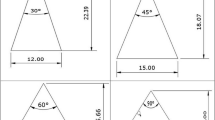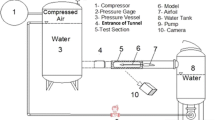Abstract
Sound pressure distribution around a monotone sound source was measured inside a marine propeller cavitation tunnel and compared with the calculated result by a two-dimensional boundary element method. The measured sound pressure distribution showed some peaks due to the reflection effect of the tunnel test section boundary. As the frequency increased, the sound pressure distribution became more complicated, showing more peaks. The tunnel reverberant effect should be taken into account when the noise data measured in the tunnel are converted into full-scale values. In the boundary element method calculation, the boundary condition at the acrylic observation window of the tunnel was examined in detail. The calculated sound pressure distribution pattern in the tunnel transverse section agreed well with the measured distribution when a reasonable boundary condition was adopted. The boundary element method is an effective method for theoretically predicting the acoustic field inside the cavitation tunnel if the precise boundary condition is adopted.
Similar content being viewed by others
Abbreviations
- G :
-
matrix whose elements areg ℓm
- g ℓm :
-
element of matrix G,\( - (\rho \omega /4)\smallint _{\Gamma _m } H_0^{(2)} (kr)d\Gamma \)
- H :
-
matrix whose elements areh ℓm
- H (2) (r)n :
-
Hankel function of the second kind of ordern
- h ℓm :
-
element of matrixH,\((jk/4)\smallint _{\Gamma _m } H_1^{(2)} (kr)\cos (\theta )d\Gamma \) when ℓ ≠m and 1/2 when ℓ ≠m
- j :
-
imaginary unit
- k :
-
wavenumber
- ℓ,m :
-
nuber of boundary element. ℓ andm denote the reference and source element, respectively
- n :
-
normal
- p :
-
complex sound source pressure whose absolute value and argument are sound pressure amplitude and phase, respectively
- p i :
-
complex sound source pressure on the boundary elementi
- r :
-
distance from sound source in the experiment, or distance between source and reference points in the boundary element method calculation
- u :
-
complex particle velocity whose absolute value and argument are velocity amplitude and phase, respectively
- γ:
-
boundary
- ρ:
-
density
- ϕ:
-
weight function
- σ:
-
circular frequency
- ∫* :
-
integral with the singular term removed
References
Suhrbier KR, Parkin BR, Alexandrov K, et al (1987) Report of the cavitation commitee. Proceedings of the 18th International Towing Tank Conference vol 1. SNAJ. Tokyo, pp 159–269
Kato H, Watanabe Y, Komura T, et al (1981) New marine propeller cavitation tunnel at the University of Tokyo (in Japanese). J Soc Nav Archit Jpn 150:148–157
Sasajima T, Oshima A (1987) Prediction of propeller cavitation noise by model test (in Japanese). Proceedings of the 5th Symposium on Cavitation. The Science Council of Japan, Tokyo, pp 129–136
Okamura N, Asano T (1988) Prediction of propeller cavitation noise and its comparison with full-scale measurement (in Japanese). J Soc Nav Archit Jpn 164:43–53
Ukon Y, Kudo T (1987) Acoustic field measurement in a cavitation tunnel. Proceedings of the 18th IInternational Towing Tank Conference vol 2. SNAJ, Tokyo, pp 105–109
Ohta K (1987) Calculation of acoustic field inside cavitation tunnel. Proceedings of the 18th International Towing Tank Conference vol 2. SNAJ, Tokyo, pp 113–116
NAOJ (National Astronomical Observatory of Japan) (1989) Chronological scientific tables 62th ed (in Japanese). Maruzen, Tokyo, pp 493–496
Saneyoshi J, Kikuchi Y, Kumamoto O (1966) Handbook of supersonic wave technology (in Japanese). Nikkan-Kogyo-Shinbunsha, Tokyo, p 1353
Author information
Authors and Affiliations
About this article
Cite this article
Yamaguchi, H., Kato, H. & Matsuda, K. Measurement and computation of the acoustic field in a cavitation tunnel. J Mar Sci Technol 1, 198–208 (1996). https://doi.org/10.1007/BF02390796
Received:
Accepted:
Issue Date:
DOI: https://doi.org/10.1007/BF02390796




